3 State of the Norwegian Sea environment
In the 2009 management plan, the state of the environment in the Norwegian Sea was described as generally good. However, the impacts of climate change and ocean acidification, overfishing of certain fish stocks, the risk of acute pollution, the decline of seabird populations and the need to protect coral habitats were identified as posing considerable challenges. The scientific basis for this update of the management plan concludes that the state of the Norwegian Sea environment is still good, and that the factors posing challenges for management of the area are still the same. This and the following chapter present updated information on environmental status and trends and on issues it will be important to address in the management regime for the years ahead. These include the impacts of climate change and ocean acidification, marine litter, the decline in a number of seabird populations and the pollution situation. This chapter also includes an account of environmental conditions in the deep-water areas of the Norwegian Sea.
3.1 General information about the Norwegian Sea
The Norwegian Sea stretches from Stad at 62 °N to the Fram Strait northwest of Svalbard. The management plan area (see Figure 3.1) covers about 1.12 million km2, including the area known as the ‘Banana Hole’. About 800 000 km2 of this is under Norwegian jurisdiction.
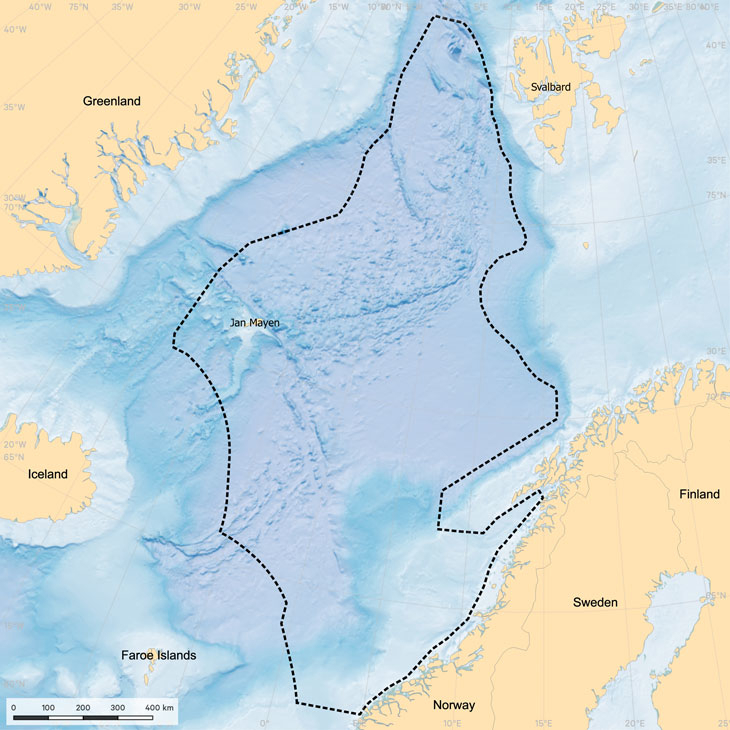
Figure 3.1 The management plan area.
Source Norwegian Environment Agency
Characteristic features of the Norwegian Sea are areas of very deep water, the warm Atlantic current (the Gulf Stream) and high biological production and biodiversity. It includes two deep-water basins where the water depth reaches between 3 000 and 4 000 metres, and shallower waters above the inner part of the continental shelf near the coast. The average depth of the area as a whole is 1800 metres. The inflow of warm, saline Atlantic water to the Norwegian Sea is about 8 million tonnes per second – eight times the total flow of all the world’s rivers. The Norwegian Sea is rich in species and supports large populations of fish, marine mammals and seabirds. There is a varied benthic fauna as a result of the great variation in water depth. Large coral reef complexes are to be found along the edge of the continental shelf. The northernmost part of the Mid-Atlantic Ridge runs through the Norwegian Sea, and includes areas with distinctive environmental conditions. Petroleum activities, shipping and fisheries and aquaculture generate substantial value added in the management plan area. The Norwegian Sea may also become an important area for the development of emerging ocean-based industries. The management plan does not establish a framework for activities in the coastal zone, which comes within the geographical scope of the Planning and Building Act.
Textbox 3.1 The continental shelf in the Norwegian Sea
According to a recommendation made by the Commission on the Limits of the Continental Shelf on 27 March 2009, the part of the Norwegian shelf that stretches beyond 200 nautical miles from mainland Norway, Svalbard and Jan Mayen covers approximately 235 000 km2.
In September 2006, Norway, Iceland and Denmark/the Faroe Islands signed a negotiation protocol on the procedure for delimiting the continental shelf in the southern part of the ‘Banana Hole’, a high seas area in the Norwegian Sea. This will be followed up with formal delimitation agreements now that the Commission has also made recommendations concerning this area to Iceland and Denmark/the Faroe Islands.
3.2 Environmental monitoring and new knowledge about the ocean climate and biological conditions
Sound knowledge about status and trends for the ocean climate and biodiversity is a vital basis for managing marine ecosystems. A coordinated system has been established for monitoring environmental conditions in the Norwegian Sea. The next part of this chapter discusses status and trends for physical and biological conditions. The monitoring system uses indicators for ocean acidification, temperature, salinity and nutrients in seawater, and transport of Atlantic water into the Norwegian Sea. Furthermore, there are indicators for the biomass and species composition of plankton and for spawning stocks and fishing pressure for several commercial fish species. There are also indicators for breeding populations of selected seabird species and the population trend for hooded seal (as a representative of marine mammals). The indicator for threatened species shows population trends and is based on the Norwegian red list. There is also an indicator for the occurrence and distribution of alien species. Appendix 1 gives a complete list of the indicators. The harp seal stock in the West Ice and selected seabirds around Jan Mayen are monitored as part of the environmental monitoring programme for Svalbard and Jan Mayen (MOSJ).
3.2.1 The ocean climate
Temperature and salinity
Long-term trends for the Norwegian Sea show rising temperature and salinity, based on time series from the late 1950s to the present (Figure 3.2). However, there are also large natural fluctuations in both temperature and salinity in the area. The temperature of the Norwegian Sea has risen markedly from the mid-1990s onwards as a result of large-scale changes in the strength of the ocean currents in the northern Atlantic. These changes mean that the Atlantic water flowing into the Norwegian Sea in the past 15 years has been warmer and more saline than previously. In 2016, the mean temperature of the Atlantic water layer in the Norwegian Sea was the highest ever measured. However, colder and fresher Atlantic water has been flowing into the southern part of the Norwegian Sea from 2014 to 2016. As this water flows northwards, both temperature and salinity are expected to decline. There is a close relationship between the temperature of the Atlantic water and its salinity, so that relatively warm and saline conditions occur at the same time.

Figure 3.2 Temperature and salinity in the southern part of the Norwegian Sea. The blue lines show the five-year mean and the red lines indicate the long-term trend.
Source Institute of Marine Research
The general trend of a changing climate is superimposed on natural variability in the ocean climate, and it is difficult to distinguish between them in the short term. Although measurements both in the atmosphere and in seawater are showing global-scale warming, there is reason to believe that natural variability will continue to be the dominant factor in Norway’s sea areas for the next 10 to 20 years.
Since 1979, the extent of the sea ice has decreased by about 8 % per decade in the northern part of the Norwegian Sea as a result of rising ocean and atmospheric temperatures.
Climate change and ocean acidification
According to the IPCC’s Fifth Assessment Report (2013 – 2014), the oceans have absorbed about 30 % of all anthropogenic CO2 emissions and more than 90 % of the energy accumulated within the climate system in the period 1971 – 2010. The cold northern seas are more vulnerable to ocean acidification than warmer waters, partly because the capacity to absorb CO2 from the air is greatest at lower temperatures. Freshwater input from melting ice and runoff from land also weaken the buffering capacity of seawater and thus the extent to which it can counteract acidification.
Monitoring of ocean acidification in the Norwegian Sea has shown considerable variability in acidity levels (pH) and carbon content over time and from one area to another. However, since the 2009 management plan was published, it has been documented that the rising CO2 content of the atmosphere is resulting in measurable acidification of the seawater in the Norwegian Sea. Monitoring of water chemistry parameters relevant to ocean acidification has been stepped up since 2011, and has improved our knowledge of acidification and natural variability in the Norwegian Sea. An analysis of historical data has confirmed that acidification is taking place more rapidly than the global average in parts of the Norwegian Sea. In the surface water of the Norwegian Basin, pH has dropped by 0.13 units over the past 30 years. Globally, pH has dropped by an average of 0.1 units from the pre-industrial level to the current average of 8.1 (this corresponds to a 30 % increase in the concentration of hydrogen ions).
So far, the biological impacts of ocean acidification have not been systematically monitored.
Textbox 3.2 Impacts of ocean acidification on ecosystems
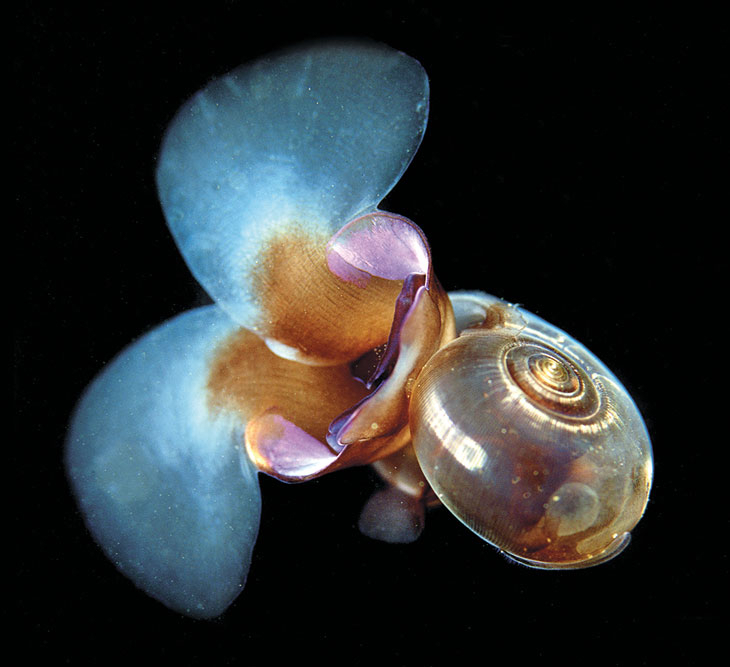
Figure 3.3 Ocean acidification can cause serious problems for species with calcareous shells like this sea snail (or ‘sea butterfly’) Limacina helicina
Photo: Erling Svensen
Laboratory studies of the impacts of ocean acidification have demonstrated adverse effects on calcifying organisms. Their calcareous shells or skeletons can begin to dissolve, but organisms can counteract this by continuing to build the shell or skeleton and increasing the energy allocated to this purpose. Some organisms are also affected directly by low pH levels, for example through effects on their metabolism. The biological availability of important micronutrients such as manganese and iron can also be altered by lower pH levels.
Ocean acidification has been shown to have adverse impacts on calcifying plankton, mollusc and echinoderm larvae and sea butterflies. Non-calcifying plankton may also be adversely affected. Large copepods such as Calanus finmarchicus, which is a key species in the Norwegian Sea, do not appear to be much affected by ocean acidification. Ocean acidification combined with changes in water temperature may negatively affect shrimps, krill, sea urchin larvae and cold-water corals, but there are still very few long-term studies of this.
Some work has also been done on commercially important species, and some studies indicate that cod larvae are vulnerable to ocean acidification. Early stages in the life cycle of lobsters and scallops are also vulnerable. However, no long-term or multi-generational studies of these species have been carried out.
3.2.2 Plankton
From just after 2000 to 2009, the quantity of zooplankton (biomass) declined throughout monitored areas of the Norwegian Sea. The lowest level measured was in 2009, when zooplankton biomass was about 40 % of the long-term average for 1995 – 2014. After 2009 there was some increase in biomass again, followed by a new drop in 2015. Observations of more southerly plankton species in the Norwegian Sea increased up to 2011, but decreased again from 2011 to 2015.
More knowledge is still needed about the impacts of different environmental pressures on zooplankton biomass, including climatic and oceanographic factors, any changes in phytoplankton production, and grazing by other zooplankton species and fish. There is also little information about how much climate change, ocean acidification, pollution and other anthropogenic pressures contribute to the cumulative environmental effects on zooplankton.
Phytoplankton play an important role in the oceans as food for zooplankton. In addition they absorb CO2 through photosynthesis, thus removing it from the atmosphere.
3.2.3 Kelp forests
Kelp forests are an important habitat for many marine organisms in the coastal zone, and have a high biomass. They are important nursery areas for fish (cod, saithe, pollack, lumpsucker, wrasses and cottids). A number of seabirds, including cormorants and shags, eider and black guillemot, are associated with kelp forests throughout the year. Kelp forests and other marine macrovegetation (in Norway seaweed and eelgrass) are sometimes referred to as ‘blue forests’. ‘Blue carbon’ is the term used for the carbon captured and stored by marine biological material.
For a good many years, kelp forests along the Norwegian coast suffered from overgrazing by sea urchins. The situation is now improving. Kelp forests are recovering in the outer zone of coastal waters as far north as Bodø, but grazing by sea urchins is still a problem in many part of the fjords.
In Norway, kelp trawling for Laminaria hyperborea takes place along the coast from Stad in Sogn og Fjordane to Nord-Trøndelag, regulated through county management plans. There is also some trawling under experimental licences in the southern part of Nordland.
3.2.4 The seabed and benthic fauna
There is a highly diverse benthic fauna on the mid-Norwegian continental shelf and continental slope, including large coral reef complexes. Stony corals form reefs that grow very slowly and that may be extremely old. Coral reefs are important because they attract a wide variety of species and form species-rich communities.
Coral reefs, coral gardens and sponge communities
Coral reefs, coral gardens and sponge communities are all formed by sessile animals that live on the seabed and form habitats for other animals (see Box 3.3). They often grow in colonies and form complex physical structures with cavities and crevices in which many different invertebrates and fish can settle and shelter. Reefs formed by the cold-water coral Lophelia pertusa can be up to 50 metres in height. Gorgonians, soft corals and sponges may grow on the reefs, and there are often many different species of crabs, other small crustaceans, starfish, brittlestars, basket stars and polychaetes that live within the reef structure, where they provide food for fish such as tusk, ling, saithe and redfish. Redfish larvae also find shelter within coral reefs.
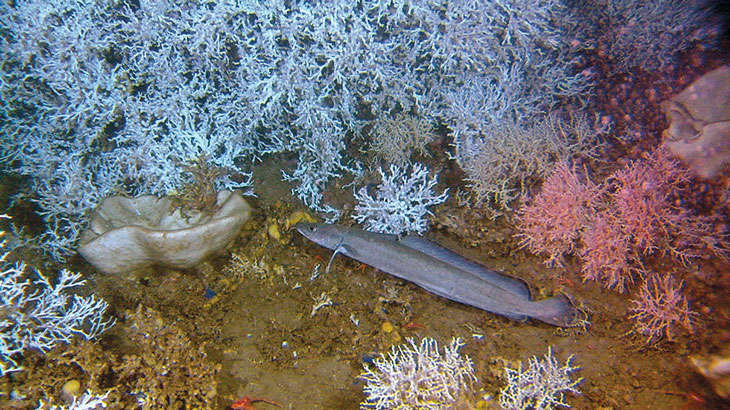
Figure 3.4 A ling on a reef with large intact colonies of corals at Storneset off the coast of Møre og Romsdal.
Source MAREANO
Textbox 3.3 Facts about corals
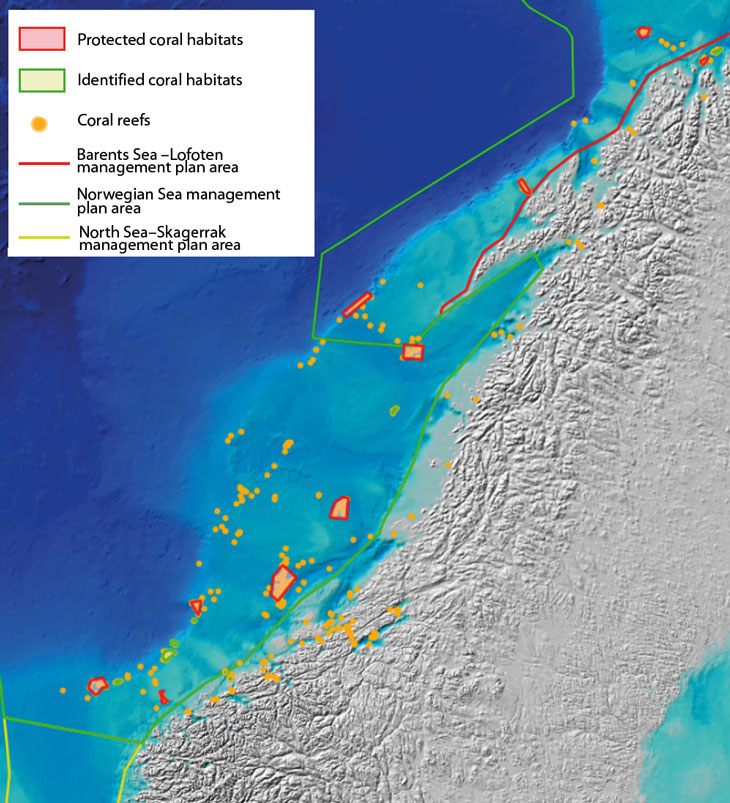
Figure 3.5 Coral habitats in the Norwegian Sea.
Source MAREANO
The anthozoans are a large and diverse group of invertebrates that includes various types of corals – stony corals, gorgonians, soft corals and sea pens – and also sea anemones. Stony corals are the only reef-building group. The most widespread and best known of the cold-water reef-building corals is Lophelia pertusa. The density of reefs of this species is probably higher in the Norwegian Sea than anywhere else in the world. Gorgonians resemble large bushes or trees, and the largest species in Norwegian waters is Paragorgia arborea, which can grow to more than 3 metres in height. Soft coral are smaller and softer, and most of them are found in tropical waters. Drifa glomerata and Alcyonium digitatum (dead man’s fingers) are two Norwegian representatives of this group.
Investigations of sediments from the continental shelf area of the Norwegian Sea have shown that there are large areas containing animals with calcareous shells or fragments of such shells. This may include smaller coral reefs and areas of coral rubble.
Sponges may grow either individually or to form large sponge communities. The latter are habitats for a wide variety of animal species that in turn provide food for fish and seabirds. Large sponge communities are quite common in shallow bank areas.
Since 2012, new knowledge on the distribution of various habitat types and vulnerable biotopes, including sponge communities, coral reefs, coral gardens and sea pen communities, in the management plan area has been acquired through the mapping and monitoring programme MAREANO. The programme has also provided information on the positions and outer limits of many registered coral reefs, and confirmation of the presence or absence of reefs at other sites (see Figure 3.5). An updated knowledge base on coral habitats needs to maintained as a basis for the conservation and management of these habitats. New information has been obtained on bottom conditions in the Møre banks and Eggakanten areas. Another two of the particularly valuable and vulnerable areas that have been identified, the Iverryggen reef and the Froan archipelago and Sula reef, have been investigated more thoroughly (see Chapter 3.4 for more information). From 2012 to 2015, 91 new coral reefs were discovered in the Norwegian Sea, but we still lack a full overview of their distribution and numbers.
Studies of the seabed in connection with planning of petroleum activities have also revealed many coral habitats on the continental shelf in the Norwegian Sea. The data that have been collected on them are being systematised.
Studies in coastal areas have shown that the distribution of many benthic organisms has shifted northwards in response to higher water temperatures. Of the roughly 1600 marine benthic species found in more southerly Norwegian waters, 565 were found to have expanded northwards by an average of 750 – 1000 kilometres in the period 1997 – 2010. In addition, well over 100 species have moved into Norwegian waters from more temperate areas between 1997 and the present.
Fishing with bottom trawls and other gear that is towed along the seabed is the commercial activity that has the greatest impact on the benthic fauna.
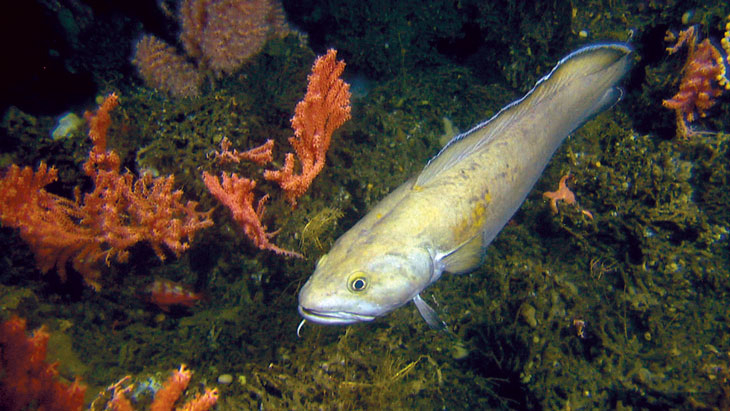
Figure 3.6 A tusk near the cold-water coral Lophelia pertusa and the sea fans Primnoa resedaeformis and Anthothela grandiflora.
Photo: MAREANO
Damage to coral habitats from fishing operations was identified as a problem in the 2009 management plan, and is still considered to be an important issue. The MAREANO programme has registered trawl tracks on the seabed down to a depth of 823 metres, and has documented damage to vulnerable habitats.
Bottom trawling affects large areas and has direct impacts on the seabed. Bottom trawling has been carried out for many years, and this is one reason why it is difficult to determine precisely when damage to coral habitats occurred. In some cases, new damage has been observed that is believed to have occurred within the past five years. Other damage is clearly older. Since there is no monitoring of registered coral habitats, it can be difficult to document changes in the pressure from bottom trawling. However, there is reason to believe that bottom trawling is putting less pressure on these habitats now than a few decades ago. The number of trawling hours by Norwegian vessels in the Norwegian Sea has been considerably reduced since the 2009 management plan was published, see Table 5.3. Regulatory measures were introduced in 1999 in the Sea-water Fisheries Regulations and the Bottom Fishing Regulations, and appear to have reduced the impacts of bottom fishing on coral reefs. In addition, trawl types that cause less damage to the seabed are being tested. As a precautionary measure, bottom trawling has also been prohibited in deep-water areas unless a special permit is obtained.
Pressures and impacts of petroleum activities on vulnerable benthic animals are further discussed in Chapter 5.3.3.
It is still not clear what impacts climate change and ocean acidification will have on coral habitats and other calcifying organisms in the Norwegian Sea. Levels of hazardous substances are generally low in sediments, and their effects on the benthic fauna have been reassessed as minor rather than moderate as previously. Monitoring of shrimps ( Pandalus borealis) in the Norwegian Sea started in 2012, and the results show that mercury levels are somewhat higher than the Environmental Quality Standard (EQS). Organisms at higher trophic levels in marine food chains that feed on shrimps may be at risk of accumulating mercury. Mercury levels in shrimps are well under the maximum permitted level in foodstuffs.
3.2.5 Valuable species and habitats in the deep sea
There are large deep-water areas under Norwegian jurisdiction in the Norwegian Sea. They include the northernmost part of the Mid-Atlantic Ridge, which is the geologically most active area in Norway. It runs through deep parts of the Norwegian Sea, and includes areas with distinctive environmental conditions and ecosystems and habitat types about which little is known. This deep-water area has large underwater mountains and rift valleys.
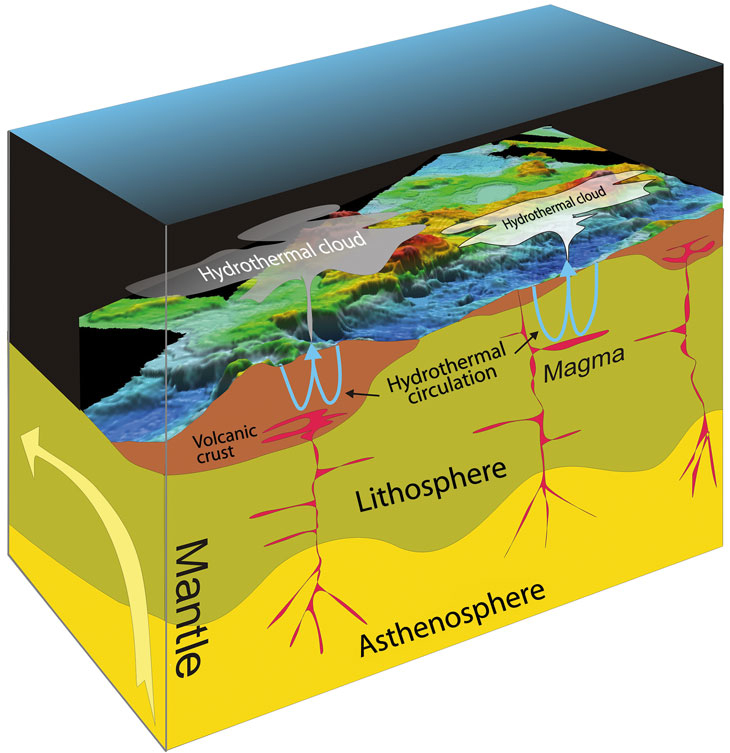
Figure 3.7 Geodynamic processes in the deep sea.
Source University of Bergen
Areas where there are hydrothermal vents and associated deposits of metal sulphides and methane hydrate (methane trapped in ice crystals) are habitats for very specialised organisms that form distinctive marine ecosystems along the Mid-Atlantic Ridge. These ecosystems are based on chemosynthesis, which means that organisms use chemical compounds in the water as a source of energy, rather than sunlight. Hydrothermal vents can be active for thousands of years. When they are no longer active, the ecosystem in the area changes from the distinctive chemosynthetic system to a normal benthic fauna. Organisms living in extreme deep-sea environments have unique adaptations to enable them to survive in the extreme conditions. Microorganisms and biomolecules can be harvested for industrial and medical uses (bioprospecting) from hydrothermal vent fields.
Mineral deposits are largely associated with inactive vent fields, and it is these areas that are of most interest for commercial exploitation of rare metals. Extensive deposits of manganese crust have also been found in the Norwegian Sea. Manganese crust is rich in a number of metals. The crust is deposited from seawater on bare rock, and contains rare, important elements that may be of great economic value.
So far, only limited research has been carried out in deep-water areas, and there has been little focus on the management of these areas.
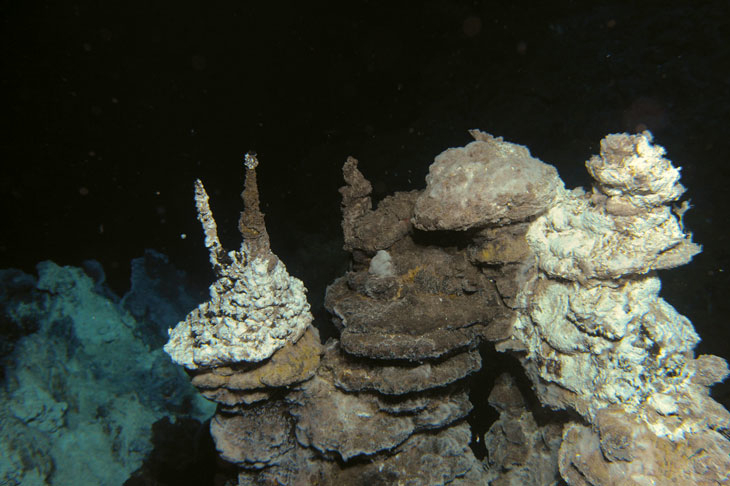
Figure 3.8 These ‘black smokers’ on the Mid-Atlantic Ridge between Jan Mayen and Bjørnøya are hydrothermal vents formed by the deposition of metal-rich sulphide minerals.
Photo: University of Bergen
Hydrothermal vents and the formation of mineral deposits
So far, seven active and two inactive hydrothermal vent fields have been discovered at depths of between 140 and 2400 metres in the Norwegian Sea. They contain metal deposits that are formed where there is an outflow of geothermal water from the seabed. When this hot, mineral-rich water mixes with cold seawater, minerals are precipitated out and form chimney-like structures. Geothermal water gushes out from the top of the vents. It contains large quantities of black or white mineral particles that make the hot water resemble smoke, and which gave rise to the names ‘black smokers’ and ‘white smokers’.
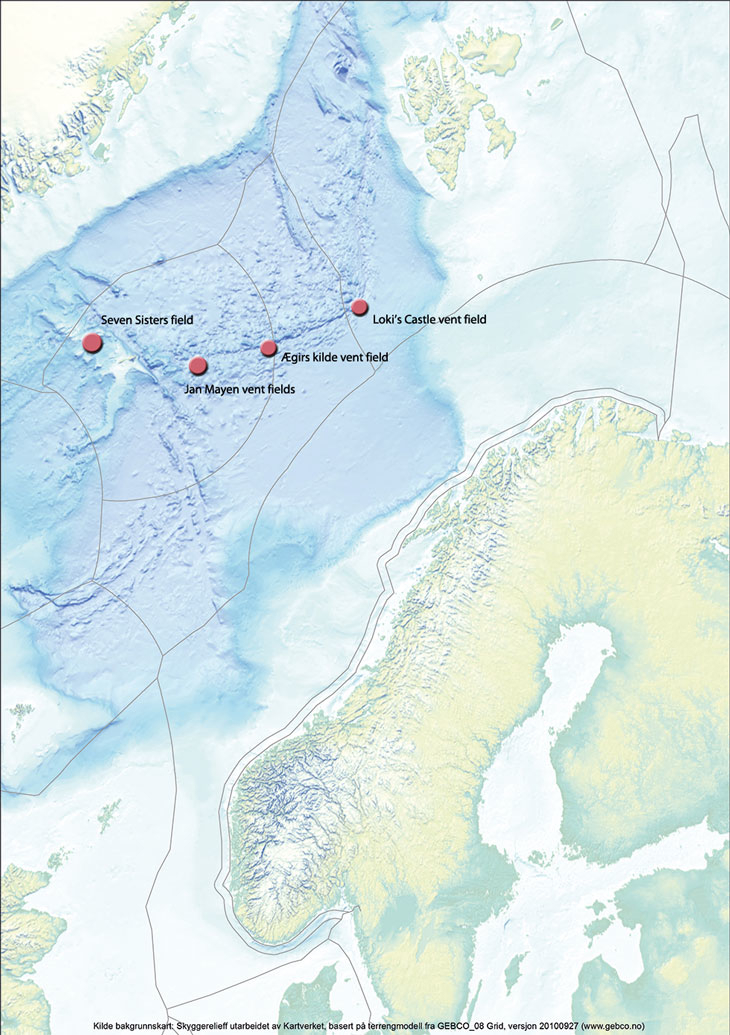
Figure 3.9 Known active hydrothermal vent fields in the Norwegian Sea.
Source Source: University of Bergen
The extent of our knowledge about the biology of the vent fields varies. Dense assemblages of sea anemones and sea squirts have been found on the Seven Sisters field. The fauna of the three Jan Mayen vent fields includes a small species of snail that grazes on the extensive bacterial mats, large sea anemones, several species of carnivorous sponges, calcareous sponges, hydroids and large numbers of sea lilies. The Jan Mayen vent fields are the best surveyed thus far. They are situated about 70 km north-east of Jan Mayen itself.
Little is known about the biology of the Ægirs kilde vent field, but a species of eelpout and various amphipods have been photographed. The Loki’s Castle vent field was discovered in 2008 and contains the largest mineral deposits so far found in the Norwegian Sea. This is also the first site in Norway’s deep-water areas where species have been found that are specifically adapted to the high temperatures around hydrothermal vents, including species that are endemic to the area.
Textbox 3.4 The Loki’s Castle vent field
The fauna of the Loki’s castle vent field is unusual even by comparison with other deep-water areas. Both the hard-bottom and the soft-bottom fauna are closely adapted to the environmental conditions. On the vent chimneys themselves, a new species of amphipod has been found, and snails and polychaetes are abundant at the base of the chimneys. The soft-bottom areas are covered with large white bacterial mats and tubeworms, snails, amphipods and polychaetes. An overview of the fauna of the area is being prepared.
There are rare habitat types and highly specialised organisms and species in areas around hydrothermal vents. It is important to investigate such areas before, during and after any commercial activities take place. Baseline studies are also needed in surrounding areas to look at the prospects of recolonisation by the original fauna.
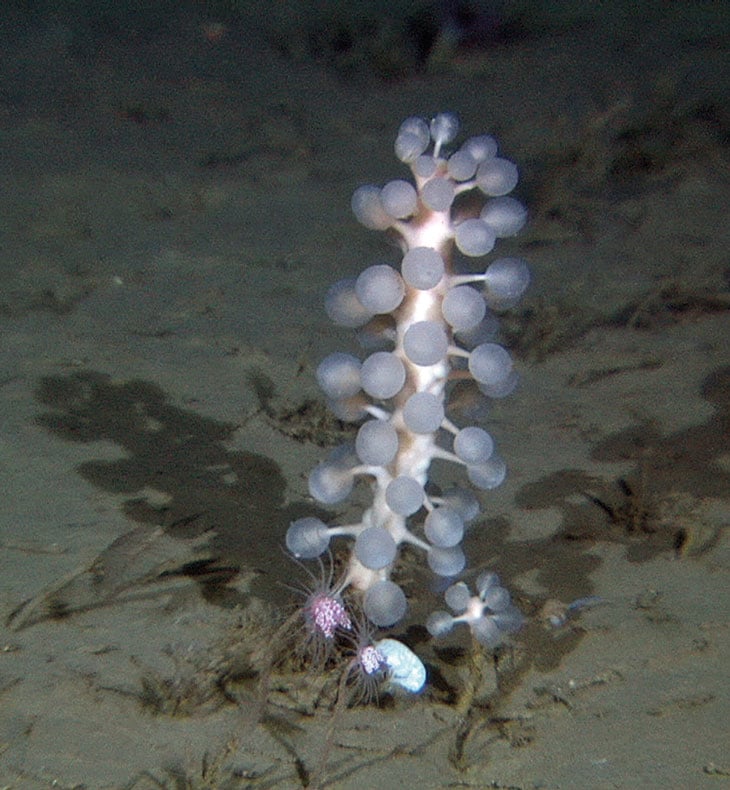
Figure 3.10 Carnivorous sponges have been found on the Jan Mayen hydrothermal vent fields. Chondrocladia grandis, is common in soft-bottom habitats in deep waters in the Norwegian Sea. This specimen was photographed at a depth of 770 metres near the edge of the continental shelf off Møre og Romsdal.
Photo: MAREANO
Methane hydrates
Methane hydrates consist of methane trapped in ice crystals in the seabed, and are only stable at high pressure and low temperature. They are found on the continental shelf and the continental slope in association with natural gas seeps. Methane hydrates can provide a source of energy, and there is therefore interest in their exploitation. There are distinctive geochemical substrates around methane hydrate deposits and cold seeps, which provide a habitat for chemosynthetic bacteria. These bacteria support a distinctive fauna not dissimilar to that found around hydrothermal vents. However, the fauna associated with methane hydrates occurs over larger areas and is quite similar in different localities.
In Norwegian waters, methane hydrate deposits have been reported around the Håkon Mosby mud volcano, in the Storegga and Nyegga areas (on the edge of the continental shelf in the southern part of the Norwegian Sea) and on the Vestnesa ridge west of Svalbard (see Figure 3.11).
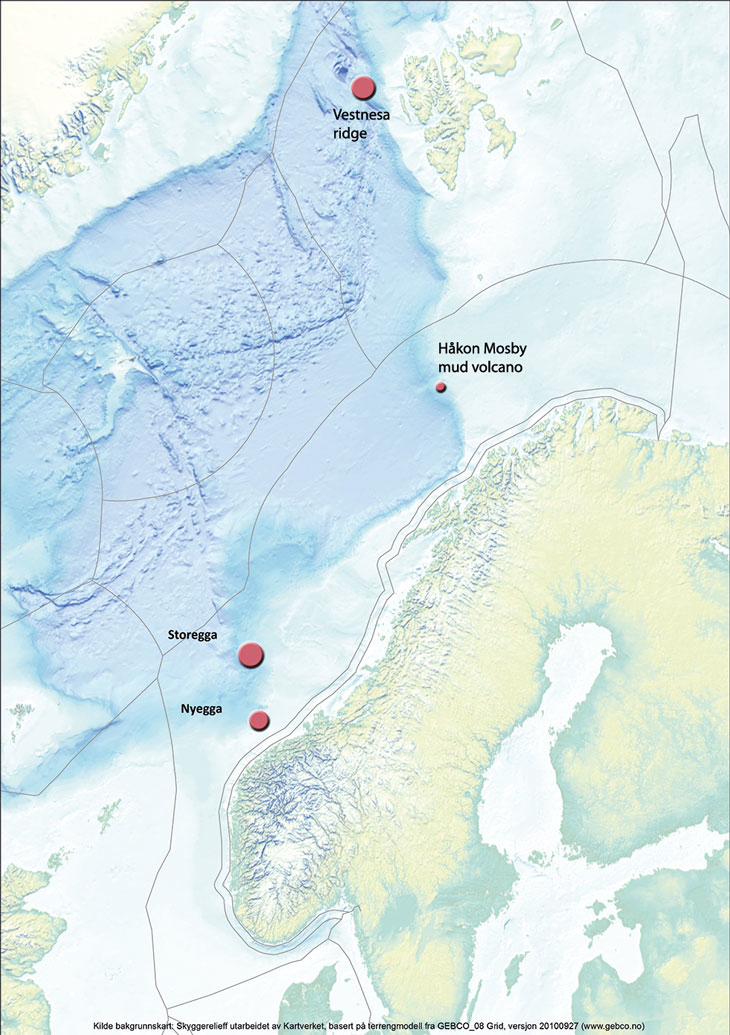
Figure 3.11 Methane hydrate deposits reported in Norwegian waters.
Source University of Bergen
The bacteria and fauna associated with methane hydrate deposits have been best studied around the Håkon Mosby mud volcano. In this area, there are dense stands of beard worms, which are polychaetes that live in long thin tubes. These in turn support a wider faunal community. The geochemical conditions appear to be more important for the fauna than the water depth.
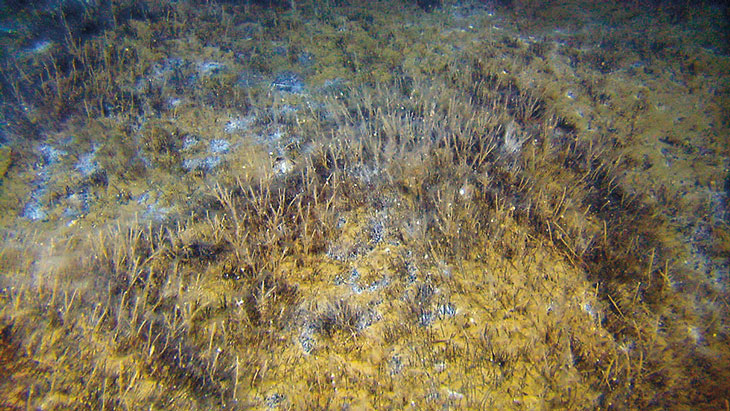
Figure 3.12 An area of cold seeps covered in bacterial mats and beard worms.
Source MAREANO
Little is known about the environmental impacts of exploiting methane hydrates.
3.2.6 Fish stocks
The Norwegian Sea fish community is dominated by three pelagic stocks; Norwegian spring-spawning herring, Northeast Atlantic mackerel and blue whiting. Some of the most important changes since the 2009 management plan have been the growth of the mackerel stock and the expansion of its distribution, the decline in the herring stock and the decline in the blue whiting stock, which is now growing again. The pelagic fish stocks are highly mobile and can cover long distances in search of food. None of these three species spends all its life in the Norwegian Sea. Both migration patterns and stock trends of the pelagic fish stocks have always been very dynamic.
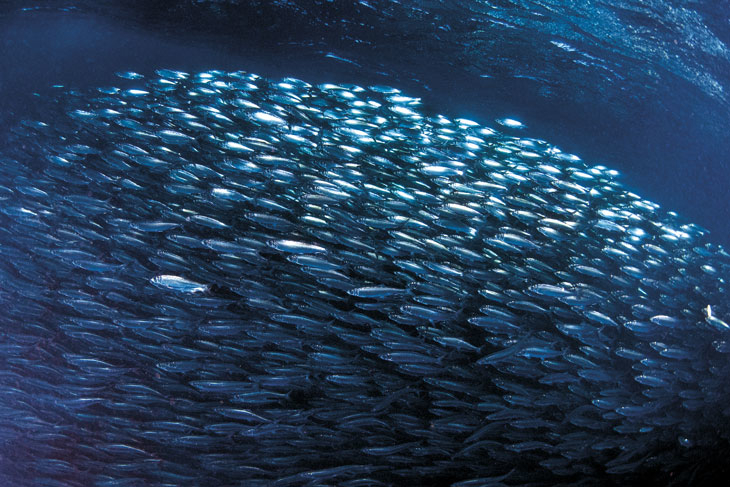
Figure 3.13 Shoal of Norwegian spring-spawning herring.
Photo: Lill Haugen/NTB scanpix
No agreements involving all the relevant countries have been concluded on the management of the three large pelagic stocks. However, there is an agreement between Norway, the EU and the Faroe Islands on management of the mackerel stock. In addition, these countries have reached agreement on the total allowable catch (TAC) and management plans for blue whiting and Norwegian spring-spawning herring for 2017. Another important stock is saithe, which is at full reproductive capacity and is being harvested sustainably. The beaked redfish stock is considered to have been fairly stable for the past 10 years, and the proportion of mature fish is high. According to the International Council for the Exploration of the Sea (ICES), the beaked redfish stock has recovered to a sustainable level. The Norwegian-Russian Fisheries Commission is preparing a management plan for this stock in consultation with ICES.
Various Atlantic salmon stocks spend considerable periods of time and important life phases in the Norwegian Sea, and a number of them spawn in Norwegian rivers. Changes and natural variability in marine ecosystems have important implications for growth stages of wild salmon and therefore for their survival at sea. Along the coast and in rivers, salmon are affected by fish farming, for example as a result of infection with sea lice at sea, and through genetic pressure and competition with escaped salmon for spawning sites in rivers. Other pressures include the salmon parasite Gyrodactylus salaris, acid rain, pollution from agriculture and other sources, and regulation of rivers for hydropower production. Overfishing of salmon stocks also used to be a considerable problem.
The Greenland halibut stock is now at a relatively high level, but is expected to decline during the next few years as a result of weaker recruitment. The stock is considered to be within safe biological limits. From 2016, ICES has introduced a precautionary level of 500 000 tonnes for the spawning stock of Greenland halibut. The stocks of blue ling and golden redfish have declined since 2009. Both species are classified as endangered in the 2015 Norwegian Red List, and recruitment to the stocks has been weak for the past ten years. ICES has recommended that no catch of these species should be permitted, and that a formal management and rebuilding plan should be established for golden redfish. The fisheries authorities have introduced a prohibition on fishing specifically for these species and have taken further steps to reduce bycatches. A need to further reduce bycatches in trawl fisheries has been identified.
The stocks of herring, mackerel, blue whiting, Northeast Arctic saithe, Northeast Arctic cod and haddock are being managed on the basis of the precautionary approach and in line with management strategies recommended by ICES. Inspection and enforcement to prevent illegal fishing has also been stepped up. The cumulative effects of the fisheries on these stocks for the period 2009 – 2016 are considered to be minor.
The distribution of the mackerel stock has been expanding as the boundary between Atlantic and Arctic water has been moving northwards and westwards in the Norwegian Sea. The increase in the distribution area of the stock is largely determined by growth in the stock size, whereas the direction of expansion is influenced by water temperature.
Higher temperatures may alter ecosystem structure and function or competition for nutrients.
Ocean acidification has not been shown to have impacts on fish stocks. The early life stages of fish are considered to be more sensitive to ocean acidification than adults.
3.2.7 Marine mammals
The West Ice population of hooded seal is stable, but it is at the lowest level ever recorded. The hooded seal is classified as endangered in the 2015 Norwegian Red List. Sealing is probably the most important direct cause of the steep population decline since the 1940s, but food supplies in the Northeast Atlantic have probably also declined in the same period. This explains why the growth of individuals and reproduction have remained low. The harp seal population in the West Ice has been growing steadily since the 1970s, and now numbers about 650 000 animals. Predation by polar bears has increased in recent decades as the extent of the West Ice has declined. An increase in predation by killer whales on harp seals has also been recorded, but not so far on hooded seals.
Data from tagging programmes and collected by a reference fleet for the Institute of Marine Research indicate that bycatches in the angler fishery may be an important reason for the substantial decline in pup production observed in the coastal grey seal population in the Norwegian Sea area from 2010 to 2014 – 2015. Other possible factors are unreported hunting and predation by killer whales. This decline has resulted in a recommendation that all hunting of grey seal should be stopped in the entire area from Stad in Sogn og Fjordane to the southern tip of the Lofoten Islands. There has also been a substantial local decline in the common seal population in Nord- and Sør-Trøndelag, which may be due to heavy hunting pressure at times. It has been recommended that common seal hunting should be halted in Nord-Trøndelag and that the quota should be greatly reduced in Sør-Trøndelag.
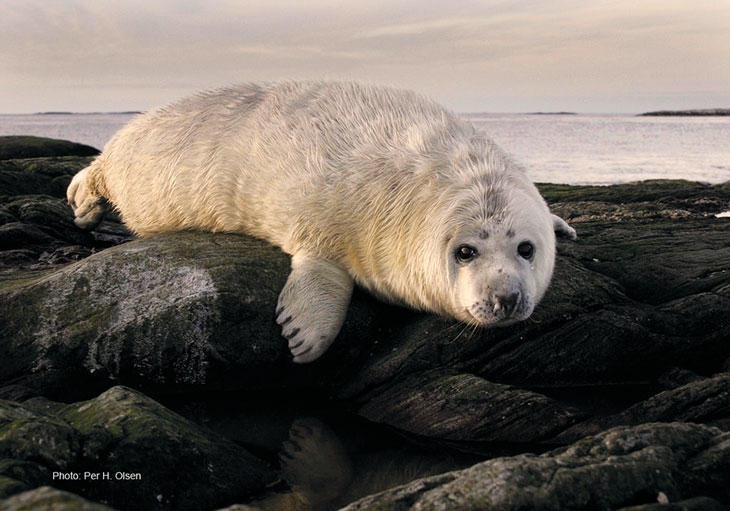
Figure 3.14 Grey seal.
Photo: Per H. Olsen/Norwegian Biodiversity Information Centre
Little is known about the occurrence of bottlenose whales, killer whales, dolphins and porpoises in the Norwegian Sea. This is partly because the behaviour of these species (deep diving, schooling) makes it difficult to obtain good data for them during the sighting surveys for minke whales. Almost all porpoises taken as a bycatch by the coastal reference fleet were caught between 60 and 70 °N, with the largest concentration in the Vestfjorden. The total bycatch in the Norwegian Sea area is estimated at about 2000 animals a year. The minke whale population is stable.
There has been a decrease in the observed levels of some classic persistent organic pollutants in hooded seals in and around the Norwegian Sea. There are generally higher levels of persistent, bioaccumulative and toxic substances in hooded seals from the West Ice than in harp seals from the same area, but so far no signs have been found of any biological effects in hooded seals. Levels of these substances in polar bears and toothed whales are still so high that biological effects at population level are to be expected. Several studies have also shown substantial concentrations of new types of persistent, bioaccumulative and toxic substances in marine mammals.
Several species of marine mammals feed on commercially exploited fish species, and fishing pressure may therefore influence the availability of food for these species. One possible example is the hooded seal, which is believed to feed on species including Greenland halibut, redfish and greater argentine.
It is also considered likely that natural variability and climate change may affect the availability of food for seals and whales. The impacts of such factors will vary from one species to another, and ice-dependent species will probably be most vulnerable.
There are large bycatches of porpoises, but it is difficult to assess what impact, if any, this has on the porpoise population before the survey results for 2016 are available. If there is a population decline, other pressures such as oil spills, hazardous substances and disease may increase their vulnerability.
3.2.8 Seabird populations
Populations of many seabirds in the Norwegian Sea have declined steeply since the early 1980s, when most monitoring programmes began. This is particularly true of the common guillemot population (critically endangered), which has dropped by 99 %, while kittiwake numbers (endangered) have decline by 78 % and puffins (vulnerable) by 75 % during this period.
For the common guillemot, the decline has been most severe in the more northerly colonies in the management plan area, particularly on the Røst archipelago (Nordland). Puffin numbers apparently remained stable for a long time at the colony on Runde (Møre og Romsdal), but here too there has been a negative trend in the last 10 years. The breeding population on Sklinna in Nord-Trøndelag has also declined. The breeding population of fulmars is declining throughout the Norwegian Sea area, and many colonies are at risk of being wiped out. Numbers of the lesser black-backed gull (subspecies Larus fuscus fuscus) along the southern Nordland coast have declined in recent years. The fulmar population in the Norwegian Sea has been greatly reduced, and there are now hardly any breeding birds left in many colonies, for example on Runde. Numbers of common eider have also declined in recent years, while shag numbers have dropped steeply on Runde but increased on Sklinna. One species that has shown a large population increase since the early 1990s is the gannet; its total breeding population has more than tripled. This is probably related to the large stocks of herring and mackerel. High levels of persistent, bioaccumulative and toxic substances have been measured in seabird eggs, giving cause for concern about the pressures and impacts of such substances on seabirds in the Norwegian Sea.
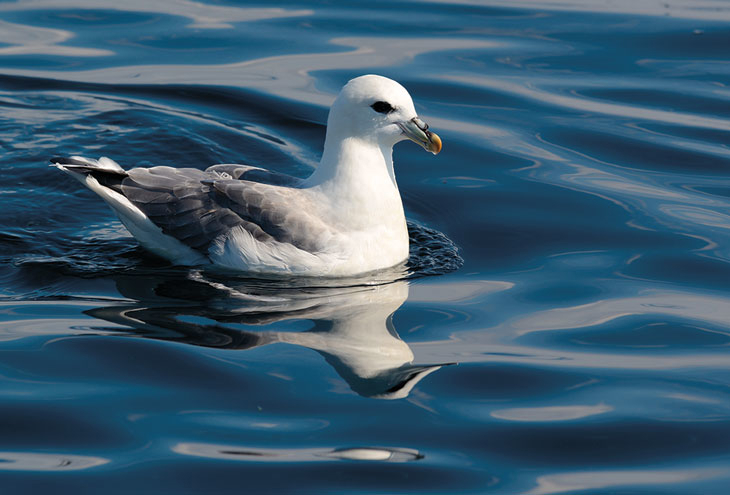
Figure 3.15 Fulmar
Photo: Tycho Anker-Nilssen, Norwegian Institute for Nature Research
After a survey of its breeding populations of seabirds in summer 2010, Jan Mayen was included as a key site of the seabird mapping and monitoring programme SEAPOP from 2012. Although the time series for Jan Mayen are still short and the results must be treated with caution, some trends are beginning to become apparent The figures indicate that populations of common and Brünnich’s guillemots are declining by 5 and 13 % per year respectively. On the other hand, the Jan Mayen fulmar population seems to be relatively stable.
Breeding success for common guillemots along the coast of mainland Norway has been poor except for the colony at Sklinna in Nord-Trøndelag, where better results may be explained by plentiful supplies of young year-classes of cod. During the breeding season, seabirds are tied to the colonies and need to find food within a limited area. Food availability near the colonies varies a great deal from year to year and is largely determined by recruitment to younger year-classes of fish and by climatic and oceanographic conditions in the sea.
Textbox 3.5 Sandeels and seabirds
Sandeels are important prey for seabirds, particularly kittiwakes, common guillemots, razorbills and puffins. Sandeels are a group of strongly schooling species in the sand lance family that are highly dependent on specific sandy substrates. Sandeels occur all along the Norwegian coast, but our knowledge of the populations of different species and where they occur along the coast is limited. Since the different species require specific types of sandy substrate, it is unlikely that it will be possible in practice to map all areas of suitable habitat along the entire Norwegian coast. The known areas of sandy substrate on which sandeels depend are in the coastal zone.
Sandeels, mainly the lesser sandeel, are monitored in central parts of the North Sea where there are large commercially harvestable stocks and where numbers have increased. Sandeels are further discussed in the North Sea – Skagerrak management plan.
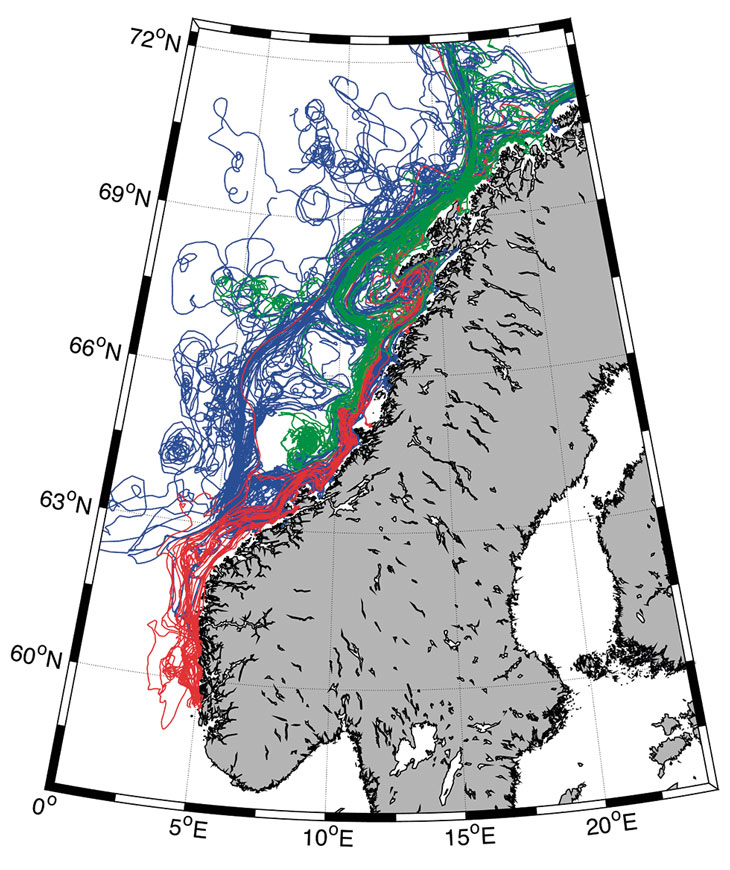
Figure 3.16 Transport of herring larvae with the currents from spawning grounds off Møre og Romsdal (blue) and more southerly (red) and northerly (green) areas in 2006.
Source Institute of Marine Research
The reason for the poor status of many of the seabird populations in the Norwegian Sea area is not clear-cut, but is related to a number of factors including reduced availability of food, greater competition for nutrition and predation pressure. Changes in the availability of food (zooplankton and small fish of pelagic and demersal species such as herring, gadids and sandeels) are very significant. Some of the changes are probably related to climate change, which can for example influence when important food species are available for seabirds. Models that show the patterns of drift of fish larvae with ocean currents can be used to build up knowledge about how variable food availability affects seabirds. The timing of larval drift larvae past seabird colonies may be of crucial importance, and there may be a strong negative impact on breeding success if it is too early or too late relative to the seabird breeding season. The availability of herring larvae is vital for good production of puffin chicks on Røst, and for other pelagic seabird species in the management plan area. The Norwegian spring-spawning herring stock has not produced a strong year-class of larvae since 2004, and this has had a serious effect on the breeding success of Norwegian populations of pelagic seabirds. Climate change will have longer-term effects on seabirds, but it is difficult to distinguish between direct and indirect effects. Indirect effects can be related to changes in fish stocks or to changes in oceanographic conditions that in turn influence the climate. One result may be that established colonies are no longer optimally sited in relation to feeding grounds. The mackerel stock in the Norwegian Sea has grown substantially since 2007, and this may have intensified competition between mackerel and seabirds for herring larvae and other prey.
A project has been carried out to find ways of reducing unintentional bycatches of seabirds in Norwegian coastal fisheries. It involved a broad-based group including representatives of the authorities, the fisheries and the research community. The project focused on measures that are relevant in specific areas and that are proportionate to the scale of the bycatch problem. The impacts of unintended bycatches of seabirds in fishing gear in the Norwegian Sea are uncertain, but bycatches have probably been reduced over time through various preventive measures. This work will be continued, and will include assessments of whether further measures are needed to reduce bycatches of seabirds.
Seabirds are particularly at risk from marine litter, especially since they can mistake fragments of plastic for food, see Chapter 4. Exposure to hazardous substances can put additional pressure on seabirds.
As a result of the decline in many seabird populations, additional pressures such as oil spills may have more serious impacts than would previously have been the case. Since the 2009 management plan was published, experience gained in cleaning and rehabilitating oil-contaminated seabirds has been evaluated, and the need for further follow-up as regards the implications for populations and animal welfare has been assessed. The conclusion was that cleaning and rehabilitation should only be carried out if the survival of individual birds is important at population level for the species in question. At present, this only applies to the lesser white-fronted goose and Steller’s eider in Finnmark.
Seabirds are further discussed in the white paper on Norway’s national biodiversity action plan.
3.2.9 Threatened species and habitat types
There has been some improvement in the conservation status of threatened species in the Norwegian Sea since 2010. In 2015, eight species were assessed as having better conservation status, including the common seal, beaked redfish and four species of molluscs, all of which were transferred to the category Least Concern (LC) and are thus no longer red-listed. On the other hand, there has been a deterioration in the status of the blue whale and four seabird species (razorbill, common tern, fulmar and Brünnich’s guillemot). The remaining species have been retained in the same red-list categories as previously. The hooded seal, bowhead whale, narwhal, spiny dogfish, basking shark, blue skate, golden redfish and blue ling are still either endangered or critically endangered. A substantial proportion of the population of most of these species is found in Norway, and several of them are listed as threatened internationally.
Only a few of the red-listed species are monitored regularly. To obtain a more representative picture of the situation of threatened species in the Norwegian Sea will require a considerable effort both to determine the conservation status of different species and to map their occurrence. The most important source of knowledge about habitat types has been mapping as part of the MAREANO programme. There is no systematic monitoring of threatened habitat types.
A list of threatened and/or declining species and habitats in need of special protection has been drawn up under the OSPAR Convention for the Protection of the Marine Environment of the North-East Atlantic.
Table 3.1 Red-listed species in the Norwegian Sea (vertebrates and anthozoans only)
Scientific name | English name | Category 2006 | Category 2010 | Category 2015 | Pressures |
|---|---|---|---|---|---|
Mammals | |||||
Balaenoptera musculus | Blue whale | NT | NT | VU | Historical harvesting |
Balaena mysticetus | Bowhead whale | CR | CR | CR | Climate change, habitat degradation (commercial activities) |
Cystophora cristata | Hooded seal | VU | EN | EN | Harvesting (very limited, research purposes), climate change |
Lutra lutra | Otter | VU | VU | VU | |
Monodon monoceros | Narwhal | DD | EN | EN | Climate change |
Fish | |||||
Dipturus batis | Blue skate | DD | CR | CR | Bycatches |
Anguilla anguilla | Common eel | CR | CR | VU | Pollution, habitat degradation, -random mortality |
Squalus acanthias | Spiny dogfish | CR | CR | EN | Pollution, climate change, random mortality |
Molva dypterygia | Blue ling | VU | EN | EN | Human disturbance, random -mortality |
Sebastes norvegicus | Golden -redfish | VU | EN | EN | Pollution, bycatches, human -disturbance, random mortality |
Lamna nasus | Porbeagle | VU | VU | VU | Climate change, random mortality |
Cetorhinus maximus | Basking shark | EN | EN | Random mortality | |
Birds | |||||
Uria aalge | Common -guillemot | CR | CR | CR | Food supply, other native species |
Cepphus grylle | Black -guillemot | NT | VU | VU | Alien species, harvesting, human disturbance |
Fratercula arctica | Puffin | VU | VU | VU | Food supply, other native species |
Alca torda | Razorbill | VU | EN | Food supply, other native species | |
Rissa tridactyla | Kittiwake | VU | EN | EN | Other native species |
Sterna hirundo | Common tern | VU | VU | EN | Other native species |
Fulmarus glacialis | Fulmar | NT | EN | Prey and predator species | |
Uria lomvia | Brünnich’s guillemot | NT | VU | EN | Food supply, other native species |
Anthozoans | |||||
Lophelia pertusa | NT | NT | NT | Habitat degradation, climate change, ocean acidification | |
Paragorgia arborea | DD | NT | NT | Habitat degradation, random -mortality |
CR = critically endangered, EN = endangered, VU = vulnerable, NT = near threatened, DD = data deficient
Source Norwegian Red List for Species 2006, 2010 and 2015.
The status of threatened ecosystems and habitat types in Norway was assessed in 2011. The mud volcano Håkon Mosby and surrounding area is the only known occurrence of this habitat type in Norwegian waters. Both this habitat type and coral reefs are listed as vulnerable, while hydrothermal vents and coral gardens are listed as near threatened.
Table 3.2 Red-listed habitat types in the Norwegian Sea
Dominant species | Habitat type | Category 2011 | Pressures |
|---|---|---|---|
Mud volcano | VU | ||
Lophelia pertusa | Coral reefs | VU | Habitat degradation |
Hydrothermal vents | NT | ||
Paragorgia arborera | Coral gardens | NT | Habitat degradation |
VU = vulnerable, NT = near threatened
Source Norwegian Red List for Ecosystems and Habitat Types 2011
A number of the red-listed species in the Norwegian Sea are threatened by human activity and the resultant habitat degradation, pollution or bycatches. In general, too little is known about the impacts of these pressures. There is a clear relationship between biodiversity conservation and ecosystem functioning and the provision of ecosystem services by an area such as the Norwegian Sea. Biodiversity and ecological interactions between species are directly related to the resilience of ecosystem functions such as biological production, habitat diversity, CO2 storage and oxygen production. These in turn are the basis for ecosystem services that we take for granted, and that are vital for food security and human welfare (see the discussion of ecosystem services in Chapter 2). The loss of biodiversity and changes to healthy animal and plant communities may have negative impacts on marine goods and services, for example making it difficult to maintain commercially important fish stocks.
3.2.10 Alien species
Alien species are species that have been introduced outside their natural distribution area by human agency. There are currently few alien species in the Norwegian Sea, but climate change and increasing maritime activity, including shipping, are increasing the risk of the spread and establishment of new alien species that may be harmful to the natural ecosystem. The Ballast Water Convention is discussed in Chapter 5.2.3.
Little is known about the occurrence and ecological effects of many alien species. There is no systematic monitoring of the occurrence of alien species in Norwegian coastal and marine waters.
However, in 2010 – 2015, 14 monitoring stations along the Norwegian coast, including the port of Narvik, were regularly investigated for the presence of alien species as part of the national programme for mapping and monitoring biodiversity. The programme has registered a number of alien species that have become established in coastal waters, including the Pacific oyster (Crassostrea gigas) in the northern part of Møre og Romsdal. This shows that alien species could potentially spread to the Norwegian Sea management area as well.
Another alien species, the comb jelly Mnemiopsis leidyi, was introduced from waters off the east coast of the US to the Black Sea with ballast water, and has since spread to large areas of the northeast Atlantic. There are for example reproducing populations in the Baltic Sea and the North Sea. If the water temperature of the Norwegian Sea rises further, reproducing populations are likely to become established here too. Even now, considerable numbers of these comb jellies are from time to time transported northwards into the Norwegian Sea with the coastal current.
3.3 Pollution
Knowledge about pollutants in the Norwegian Sea is needed to gain an overview of the environmental status of the area, in addition to knowledge about the ocean climate and biodiversity, as discussed above. The information provided below is based on indicators for selected hazardous substances in marine organisms and for inputs of pollutants. Appendix 1 lists all the indicators used in the monitoring programme.
3.3.1 Sources of pollution
The main source of pollution in the Norwegian Sea is long-range transport with air and ocean currents. Since the previous management plan was published, the models for inputs of pollution have been further developed. In 2011, new calculations by the Norwegian Environment Agency using results from the Marine Pollution Monitoring Programme showed that inputs of hazardous substances via ocean currents and atmospheric transport are much higher than estimated in the 2009 management plan. The higher estimates are largely explained by improvements in how the models describe inputs of pollutants. There is little to suggest that there has been a real increase in inputs. Hazardous substances that are still in use or are present in the environment because of earlier use are spread with winds and ocean currents to the Norwegian Sea. Inputs from Norway’s land areas and the coastal zone are also included in the calculations as external pressures on the management plan area. The total contribution from long-range transport of pollutants is considerably larger than the contribution from local sources for all the substances that have been investigated. The only exception is oil, since shipping and petroleum activities are sources of oil pollution within the management plan area.
3.3.2 Environmentally hazardous substances and oil
Inputs of selected priority hazardous substances are monitored at Birkenes in Aust-Agder, Ny-Ålesund in Svalbard and since 2010, at Andøya in Nordland. The results from Ny-Ålesund show stable or decreasing and low concentrations of hazardous substances in air, with the exception of rising concentrations of the persistent organic pollutant hexachlorobenzene (HCB). Levels of most substances are rather lower at Andøya than in Ny-Ålesund, but it is too soon to identify trends. There is very little data from western parts of the Norwegian Sea, but measurements from Jan Mayen in 2009 – 2011 showed generally low concentrations of hazardous substances in air and water.
Levels of hazardous substances in the water column are low, as are levels of most hazardous substances in sediments in open sea areas of the Norwegian Sea. Studies suggest that inputs of mercury, lead and PAHs (polycyclic aromatic hydrocarbons) from combustion have shown a weak rise in the last 100 years. Although levels of hazardous substances measured in sediments and the water column are low, certain substances bioaccumulate and are found at relatively high levels in particularly vulnerable species at the top of food chains. Studies carried out since the 2009 management plan was published show that concentrations of these pollutants in some fish species, edible crab, seabirds and marine mammals are so high that they give cause for concern. In certain species, concentrations of some organic pollutants and mercury are high enough that they could have adverse effects at individual level.
Classification systems are used in assessing whether the measured levels of a particular substance are of concern in the environment, and whether they are so high that it is necessary to take action. People and marine organisms often exhibit different levels of tolerance to hazardous substances, and their exposure to these substances also differs. Different systems have therefore been put in place to protect people and marine organisms against the possible adverse impacts of hazardous substances. The levels specified in environmental quality standards (EQS) are often lower than the maximum permitted concentrations of hazardous substances in seafood.
In fish, concentrations of hazardous substances are generally highest in large, long-lived species at higher trophic levels, such as Greenland halibut and cod. Despite the generally low pollution levels, the EQS for mercury is exceeded in several indicator species (shrimp, cod, herring, tusk, Greenland halibut and minke whale). In several indicator species of fish, the EQS for liver is exceeded for one or more organic pollutants. Fillet meat of Greenland halibut also contains certain organic pollutants at concentrations exceeding the EQS.
High concentrations of hazardous substances have also been measured in seabird eggs. There has been a decrease in the observed levels of some classic POPs in hooded seals, while levels of these substances in other species, for example toothed whales, are still so high that biological effects are to be expected at population level. Significant levels of new types of hazardous substances have also been found in several studies of seabird eggs and marine mammals.
More knowledge and information is needed about hazardous substances and whether their combined effects can reduce species tolerance to other pressures such as climate change, changes in the availability of prey and disease.
On the whole, concentrations of undesirable substances in seafood are below the maximum permitted levels, and seafood from the Norwegian Sea is generally considered to be safe. However, Greenland halibut has proved to be an exception. Bioaccumulation in this species can result in concentrations of mercury, dioxins and dioxin-like PCBs that are too high. In baseline studies, Greenland halibut caught along the edge of the continental shelf south and west of the Lofoten Islands contained concentrations of certain organic pollutants exceeding the maximum permitted levels. The fisheries authorities therefore decided to close fishing grounds in the area. The source of these pollutants is not clear, but is most likely to be long-range transport. Results from the period 2013 – 2015 showed an improvement in the situation, and the fishing grounds along the edge of the continental shelf were re-opened in 2016. Mercury concentrations in Greenland halibut have also been found (2011 – 2012) that are well above the EQS but lower than the maximum permitted level in seafood.
Levels of dioxins and dioxin-like PCBs in the fatty liver of coastal cod are also high, and the average level in 2012 – 2014 exceeded the maximum permitted level in seafood. A large-scale survey of tusk and ling in 2013 – 2016 showed that the liver from fish caught in coastal and marine waters of the Norwegian Sea south of the Lofoten Islands contained concentrations of dioxins and dioxin-like PCBs exceeding the maximum permitted level. Fillets of tusk from the Vestfjorden were found to contain mercury at concentrations above or just below the maximum permitted level. Furthermore, high levels of cadmium have been found in edible crab north of Bodø, and restrictions on crab sales have therefore been introduced in certain areas. During the past 10 years, a more integrated monitoring system has been built up for undesirable substances in fish. In addition to providing data relating to food safety, this is helping to build up time series for concentrations of hazardous substances in seafood.
Inputs of oil to the Norwegian Sea may originate from operational discharges or from acute pollution from shipping, petroleum activities and land-based activities. Operational discharges of oil are considered to have little environmental impact.
Produced water is extracted from oil wells together with the oil and contains oil residues, naturally-occurring hazardous substances and residues of substances added during the production process. In the 2009 management plan, operational discharges of produced water were not considered to have measurable impacts at population level on the species that were assessed. However, there was uncertainty about the long-term effects of produced water. The knowledge base has been improved through several studies of the effects of produced water that have been completed since 2009 (see Box 3.6).
Textbox 3.6 Environmental effects of produced water
A ten-year research programme on long-term effects of discharges to sea from petroleum-related activities (PROOFNY) has been carried out as part of the Oceans and Coastal Areas programme under the Research Council of Norway. Results from the programme were published in 2012 and in the final report from the Oceans and Coastal Areas programme in 2016. The PROOFNY programme focused particularly on certain PAHs and alkyl phenols, but actual samples of produced water were also investigated.
It has been found that components in produced water can have a range of negative impacts on health, biological functions and reproduction in individual fish and invertebrates. The 2012 report concluded that the potential for long-term environmental damage as a result of discharges of produced water is only moderate, and that concentrations of components that have had adverse impacts are not generally found more than one kilometre from discharge points. The report also concluded that it is still very uncertain whether effects on individuals and communities close to discharges have repercussions on larger areas, populations and communities.
According to the final report from the Oceans and Coastal Areas programme in 2016, research and monitoring results indicate that there is only harmful exposure to discharges of produced water and water-based drilling mud in an area stretching no more than 1 – 2 km from a discharge point. According to the report, this means that the probability of effects at population level is low. The results of environmental monitoring support this conclusion.
Research now being carried out includes studies of the long-term effects of exposure to low doses of oil on early life stages of haddock. These studies are to be completed in 2017.
3.3.3 Nutrients
Nutrients enter the management plan area mainly in the Gulf Stream (the Atlantic current) and the Norwegian coastal current. The latter carries nutrients from industrial areas in continental Europe, land areas around the Kattegat and Skagerrak, and from rivers, agriculture, waste water and fish farms along the Norwegian coast. Atmospheric inputs of nitrogen also account for a significant proportion of the total.
Since 1990, total inputs for nutrients to coastal areas bordering on the Norwegian Sea have risen. Inputs of phosphorus have tripled in this period and inputs of nitrogen have risen by 50 % (Figure 3.17). This is largely explained by a rise in discharges from agriculture. However, the inputs to coastal waters are not measurable in open sea areas of the Norwegian Sea, where inputs are dominated by nutrients transported by the Atlantic current. Monitoring results show that neither long-distance transport of nutrients nor discharges in coastal areas have had impacts on the management plan area.
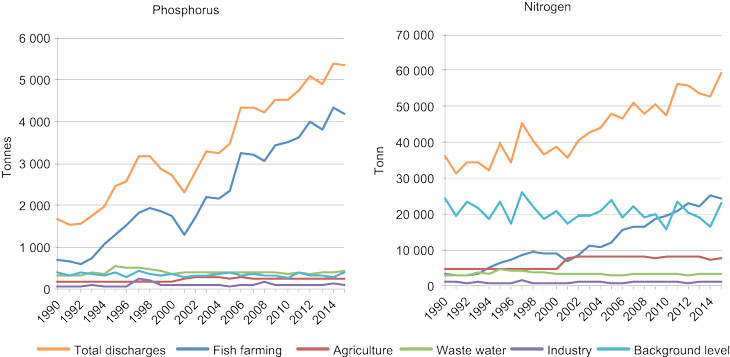
Figure 3.17 Inputs of nutrients to the coastal zone from land.
Source Norwegian Environment Agency
3.3.4 Radioactive substances
The main sources of radioactive pollution of the Norwegian Sea are fallout from atmospheric tests of nuclear weapons, fallout from the Chernobyl accident in 1986, and discharges from reprocessing facilities for spent nuclear fuel (Sellafield and Cap de la Hague). Discharges of produced water also contain naturally occurring radioactive substances.
Atmospheric nuclear testing was halted in 1980, and this combined with better control and abatement of emissions from reprocessing plants has eliminated or reduced the most important sources of radioactive pollution of the Norwegian Sea.
Abatement technology at the Sellafield processing plant has reduced emissions and resulted in lower levels of technetium-99 and strontium-90 in Norwegian waters. Releases of technetium-99 from Sellafield have been greatly reduced since new technology to remove technetium from the waste stream was taken into use in 2004 (Figure 3.18).
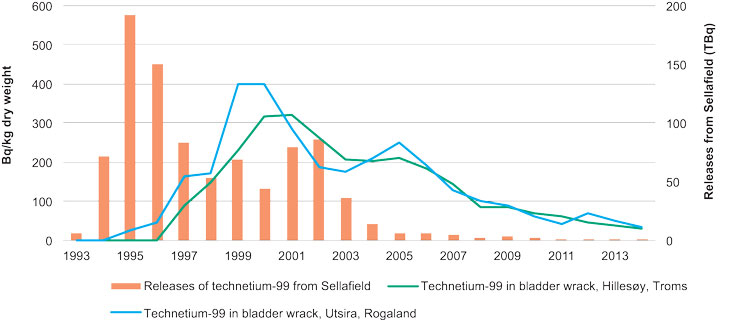
Figure 3.18 Concentrations of technetium-99 measured in bladder wrack along the Norwegian coast.
Source OSPAR Commission, British Nuclear Group, Institute for Energy Technology, Norwegian Radiation Protection Authority
Radioactive substances from the Chernobyl accident are spread with precipitation and the outflow of water from the Baltic Sea to the Norwegian coastal current and through the Norwegian Sea to the Barents Sea. Radioactive pollution from the Chernobyl accident is still present in the Norwegian Sea.
The risk of damage associated with radioactivity depends on the radiation dose and the type of radiation Levels of radioactive pollution in seawater, sediments and biota are low and generally declining. This trend is explained by radioactive decay, sedimentation and dilution, in addition to the reduction in releases of radioactivity. Levels of radioactivity in seawater are not considered to be harmful for marine life or for humans through consumption of seafood.
3.3.5 Underwater noise
Growing attention is being paid to the possible impacts of underwater noise on marine species. The main sources of underwater noise in the Norwegian Sea are propeller noise from shipping, seismic surveys and the use of military sonar (see Chapter 5.2.3 and 5.3.3). The construction of offshore wind farms could also increase noise levels.
In the 2009 management plan, it was concluded that seismic surveys only have minor impacts on fish and insignificant impacts on marine mammals in the form of behavioural changes. Since then, more knowledge has been acquired on the effects of underwater noise from various sources on fish and marine mammals, but we still know too little to draw clear conclusions on the impacts of underwater noise. For the Norwegian Sea management area, seismic surveys are still considered to have only minor impacts on fish.
New knowledge has altered our understanding of noise and the impacts on whales of noise in the form of sound pulses from seismic surveys and sonar. Several whale species have proved to be very sensitive to military sonar. Research carried out in other countries has given inconsistent results as regards the behaviour of different species of whales. There are few studies of the impacts of seismic sound sources on marine mammals in Norwegian waters.
The scientific basis for this update of the management plan concludes that it is unlikely that noise from shipping has direct negative impacts on fish and marine mammals, but that temporary scare effects are to be expected. Given new knowledge obtained in the last few years, the International Maritime Organization (IMO) now considers underwater noise from shipping to be a greater problem than was previously the case. This applies particularly to marine mammals and to a lesser extent to other marine animals.
The impacts of underwater noise on fish in the management plan area are still considered to be minor, but more knowledge is needed about the impacts of underwater noise.
3.3.6 Environmental impacts of acute pollution
There are acute pollution incidents involving shipping and the petroleum industry every year. Most spills in the Norwegian Sea since 2009 have been small and the total quantity of oil in spills has been small compared with operational discharges
The environmental impacts of oil or chemical spills depend on a variety of factors, including their timing and location, the species and habitats affected and the vulnerability of the area, the type of spill and its volume, weather conditions and the emergency response measures initiated. The effects, especially on seabirds and fish, can be very serious if there is a large spill in unfavourable circumstances. This applies above all to the particularly valuable and vulnerable areas (see 3.4 below). However, the probability of a large spill is low. For a further assessment of the environmental impacts and environmental risk associated with acute pollution, see Chapter 5.2.3 and 5.3.3.
3.4 Particularly valuable and vulnerable areas
Particularly valuable and vulnerable areas are those that on the basis of scientific assessments have been identified as being of great importance for biodiversity and biological production in the entire management plan area. They are selected using predefined criteria, the main ones being that the area concerned is important for biodiversity or for biological production. The designation of areas as particularly valuable and vulnerable does not have any direct effect in the form of restrictions on commercial activities, but indicates that these are areas where it is important to show special caution.
In 2012 – 2013, the MAREANO programme mapped the particularly valuable and vulnerable areas in the Norwegian Sea, largely within the areas that were already delimited. This work was not done with the aim of assessing the delimitation of the areas. In the Sula reef area, new coral structures were identified within the established boundaries of the area. Geological mapping suggests that the coral reef extends beyond the area as it is currently delimited, but this has not yet been verified.
In the 2009 management plan, the areas described below were identified as particularly valuable and vulnerable (see Figure 3.19).
The Remman archipelago
The Remman archipelago lies on a shallow plateau projecting out into the Norwegian Sea beyond the island of Smøla in northwestern Møre og Romsdal. This is a characteristic shallow-water area and a core area for kelp forest dominated by Laminaria hyperborea. The archipelago is also important for seabirds both during and outside the breeding season. The area has been protected as a nature reserve, and is one of the areas that have been proposed for inclusion in the marine protection plan.
The Froan archipelago and Sula reef
This area covers an important transect from coastal waters to the open sea. Several fish stocks, including Norwegian spring-spawning herring, spawn within the area, thus also providing good food supplies for other species. The Froan archipelago is an important breeding area for grey and common seals and a key feeding area for many species of seabirds both in the breeding season and at other times of year, particularly coastal species such as cormorant, shag, marine diving ducks, lesser black-backed gull and black guillemot.
The Sula reef has been designated as particularly valuable and vulnerable because of the major coral reef complex formed by Lophelia pertusa. Biodiversity is generally high on and around coral reefs. Some important species such as golden redfish, ling, tusk and saithe are associated with the reef complex. The use of bottom fishing gear in the area was banned in 2000, and it is now a marine protected area.
The Sula reef complex has been mapped before, but several new finds have nevertheless been made. Two new coral reefs were documented within the marine protected area in autumn 2012, and more than 15 coral reefs have been registered outside the protected area in the northeastern part of the reef complex. Three additional coral reefs were also found in an adjacent sea area in spring 2012. The Sula reefs are considered to be in very good condition.
The Møre, Halten and Sklinna banks
All three of these bank areas are core areas for spawning and early life stages of herring and saithe. Herring are benthic spawners and require a specific substrate. They use the same spawning grounds year after year, but the proportion of the stock that spawns in different areas may vary over time. The Møre banks are also an important spawning and nursery area for Northeast Arctic cod and haddock. The Halten and Sklinna banks are in addition highly productive retention areas for drifting fish eggs and larvae. The Møre banks are important feeding grounds for many seabird species, including gannets, common guillemot, puffin and razorbill. The Halten and Sklinna banks are important feeding areas for many seabirds outside the breeding season.
There are also marine mammals, particularly common and grey seals, and also porpoises. There are several coral reef complexes, the riches of which, Breisunddjupet in the Møre banks area, is protected against the use of bottom fishing gear. The MAREANO programme registered three new coral reefs in the Møre banks area in 2012 – 2013, all of them close to previously registered reefs. Soft corals were also observed at four different localities.
The Iverryggen reef
This area is considered to be particularly valuable because it contains the important Iverryggen reef complex. Other important species associated with the reefs include golden redfish, ling, tusk and saithe. The area was protected against the use of bottom fishing gear in 2003.
Since the 2009 management plan was published, the MAREANO project has verified a further four new coral reefs in this area. The coral reefs in this area are considered to be in good condition. Sponge and sea pen communities have also been observed in the shallower parts of the Iverryggen reef complex.
The Vestfjorden
The Vestfjorden is a very important area for Norway’s two most important fish stocks, Northeast Arctic cod and Norwegian spring-spawning herring. It is also an important wintering area for the planktonic copepod Calanus finmarchicus and is a valuable area for many seabird species throughout the year. Moreover, the Vestfjorden is important for marine mammals such as the grey seal, killer whale, minke whale and porpoise.
The Vestfjorden is part of an area lying above the continental shelf in North Norway that is particularly important for spawning fish, eggs, larvae and juvenile fish. It plays an especially important role for early stages of fish stocks that live in the Norwegian Sea and Barents Sea. The Træna reef at the entrance to the Vestfjorden was protected against the use of bottom fishing gear in 2010.
Jan Mayen and the West Ice
The Jan Mayen area is important for breeding seabirds: there are 15 breeding species and 22 different seabird colonies. In all, 300 000 pairs of seabirds breed in the area. The West Ice, north and west of Jan Mayen, is a core breeding area for hooded and harp seals.
Eggakanten
The edge of the continental shelf is the transitional area between the relatively shallow continental shelf and bank areas along the mainland and the deep-water areas of the Norwegian Sea, and runs all the way from Stad in Sogn og Fjordane to northwestern Svalbard. Biological production and biodiversity are high in the area, there are large concentrations of many fish and seabird species, and there are large coral reef complexes and other coral structures. Early life stages of herring and cod drift northwards along the edge of the continental shelf. There are also important spawning grounds for deep-water species such as golden redfish, beaked redfish, Greenland halibut and greater argentine. Moreover, the area is an important feeding ground for whales, and very important for many seabirds, particularly kittiwakes and auks.
In 2012 – 2013, ten new Lophelia pertusa reefs were registered along the edge of the continental shelf during mapping by the MAREANO programme. Two were in the Storegga area (Møre og Romsdal) where coral reefs had already been registered. In the northern part of the area, up to the southern part of the Skjoldryggen moraine system (southern Nordland), eight new Lophelia pertusa reefs were discovered that are not in the proximity of other previously registered reefs. Soft corals, which can form coral gardens, have been registered at 22 localities along the edge of the continental shelf. Seven of these are Lophelia pertusa reef areas where soft corals are also common. In 2015, a new reef complex was discovered further north, off Sandnessjøen. This is a narrow reef complex consisting of 24 reefs and extending for about 1 kilometre along iceberg plough marks.
The Arctic front
The Arctic front is the zone where Atlantic and Arctic water meet. In biological terms, it is a narrow zone stretching all the way through the Norwegian Sea where biological production is high and there is a rich diversity of animal species. The Arctic front is dynamic, and varies in position and geographical extent. The high biological production makes this an important feeding area for several whale species, including blue whale, fin whale, minke whale and northern bottlenose whale.
The coastal zone
The coastal zone is the area stretching outwards from the baseline to 12 nautical miles from the baseline, in other words the part of the management plan area closest to the coast. The section of the coastal zone from Stad to Runde, the coast of Sør- and Nord-Trøndelag (including the Froan, Vikna and Sklinna archipelagos) and the southern part of Nordland (including islands and skerries in Sømna and Vega municipalities), the Remman archipelago and the Vestfjorden are considered to be particularly valuable and vulnerable. The area on the landward side of the coastal zone is also very important, and the environmental value of these areas must be considered as a whole. There is a wide variety of biotopes, ecosystems and species in the coastal zone. Many species use the whole area near the coast as a habitat and feeding area, and there are many areas of special importance for local fish stocks and seabirds along the coast of the Norwegian Sea.
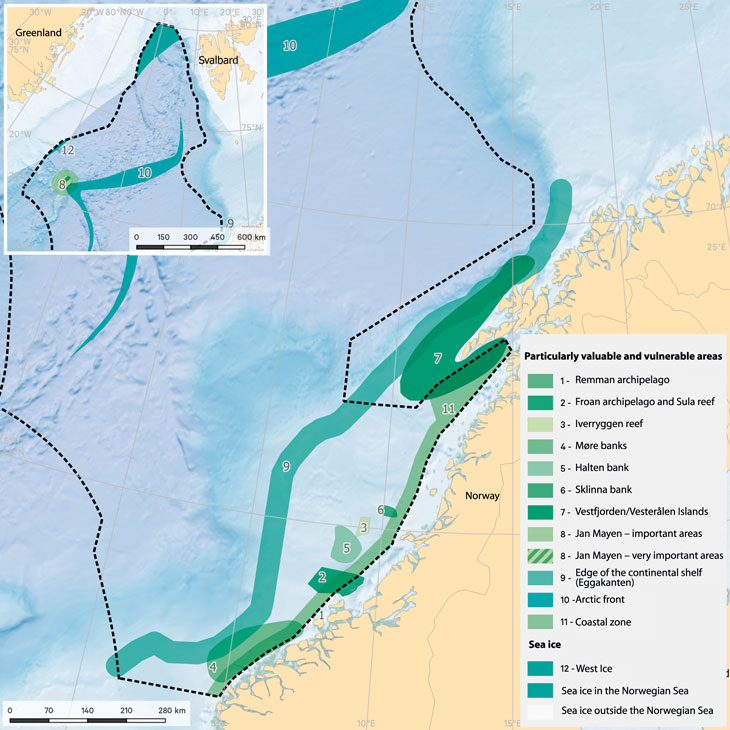
Figure 3.19 Particularly valuable and vulnerable areas in the Norwegian Sea.
Source Norwegian Environment Agency/Institute of Marine Research
3.5 Important knowledge needs
The 2009 management plan identified a number of areas where there were gaps in our knowledge about the Norwegian Sea. These included species, habitats, ecosystem structure and functioning and pressures and impacts on ecosystems from various human activities. A great deal of new knowledge has been acquired since then, for example on ocean acidification, trends in seabird populations and benthic communities in the particularly valuable and vulnerable areas. Nevertheless, there are various areas where further research, mapping and monitoring is needed to improve the knowledge base for integrated, ecosystem-based management. The most important of these are outlined below.
Climate change and ocean acidification
More knowledge is still needed about the impacts of climate change and ocean acidification on the dynamics of ecosystems and their capacity to provide important ecosystem services, and how climate change and ocean acidification interact with other pressures.
Modelling of the impacts of climate change on marine mammals is also needed, particularly as regards the northern Norwegian Sea, to examine how changes in ice cover, temperature, food supplies and pathogenic organisms affect different species.
The seabed
There is a need for mapping of the distribution of habitat types outside the particularly valuable and vulnerable areas to supplement knowledge about habitat types within these areas.
Research cruises in certain areas have documented distinctive species, habitats and ecosystems in deep-water areas, particularly near the Mid-Atlantic Ridge, but so far our knowledge of these areas is incomplete. Habitat types, species diversity and mineral deposits should all be mapped in these areas. Mapping and research in deep-water areas will strengthen the basis for management of the submarine environment and for the possible exploitation of resources for bioprospecting or mineral extraction.
Fish stocks
The major pelagic fish stocks play a dominant role in the Norwegian Sea ecosystem. It is important to learn more about interactions between herring, mackerel and blue whiting and how they are affected by changes in the quantity of zooplankton in the ecosystem.
A better understanding of natural interactions in the ecosystem is also needed. The important issues will vary between fish stocks, but more knowledge is for example needed about the ecosystem effects of the fisheries and the types of effects they have on healthy and weak stocks.
More knowledge is also needed about mesopelagic fish species and their role in the ecosystem. Moreover, we need to know more about how harvesting species at lower trophic levels, for example copepods such as Calanus finnmarchicus, may affect the ecosystem.
Seabirds
Major changes are taking place in seabird populations along the coast. Studies are needed to identify the causes and find links between ecosystem processes and population changes. Some studies suggest that there are close links between the ocean climate, larval drift and declining seabird populations. Further studies of such interactions are needed.
In many cases, we know very little about the diet of different seabirds during the year, both along the coast and in the open sea. Since many species are specialists and thus very sensitive to changes in supplies of their prey, knowledge of their diet is of crucial importance for identifying and quantifying both natural and anthropogenic environmental pressures.
Marine mammals
Regular updates of data, for example on changes in sea ice extent and prey species, are needed to understand the responses of marine mammals to environmental change. In addition, better data on migration patterns and habitat use are needed for both seals and whales in the Norwegian Sea to make it possible to assess the effects of human activity in relevant areas. Better data are also needed on population sizes and the geographical distribution of whales other than minke whale, particularly the common porpoise.
Hazardous substances
Knowledge about the sources, inputs and spread of hazardous substances is limited, and in particular we know little about inputs of hazardous substances from different sources to the water column and entering food chains.
More knowledge about inputs, levels and possible effects of hazardous substances at individual, population and community level is needed to make overall assessments of the pollution situation in the Norwegian Sea. In addition, more knowledge is needed about new substances that are not being monitored at present and about the synergistic effects of hazardous substances, especially in seabirds, marine mammals and polar bears.
Underwater noise
Both fish and marine mammals are affected by underwater noise, but our knowledge of the cumulative effects of noise pollution from activities in the Norwegian Sea is limited. Knowledge about the effects of anthropogenic underwater noise, particularly on fish, has been greatly expanded in recent years. However, we still need to know more about how underwater noise from human activity in the management plan area affects marine mammals.
Environmental monitoring
There is a need to further develop several of the indicators used for environmental monitoring or to improve reporting by making the information more accessible or improving the monitoring system. For example there are gaps as regards monitoring of benthic communities, alien species, threatened species and pollution. Monitoring of pressures and impacts associated with human activity needs to be further developed, as does our understanding of which changes are a result of human activity and which are related to natural processes in the oceans. Better and more cost-effective methods also need to be developed for us in mapping and monitoring Norway’s sea areas.